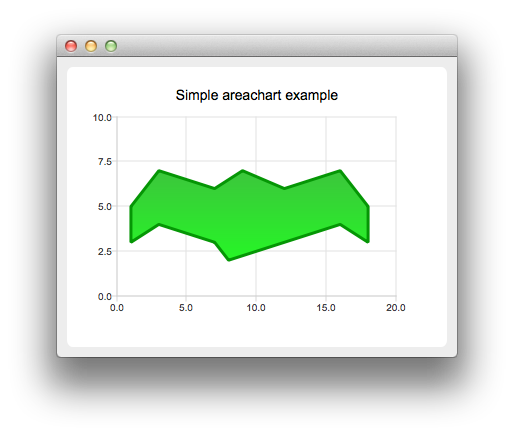
The example shows how to create a simple area chart.

To run the example from Qt Creator, open the Welcome mode and select the example from Examples. For more information, visit Building and Running an Example.
To create area charts, we need two QLineSeries instances. They are going to define the upper and lower boundary of the area.
QLineSeries *series0 = new QLineSeries(); QLineSeries *series1 = new QLineSeries();
We add data to both series and use the stream operator.
*series0 << QPointF(1, 5) << QPointF(3, 7) << QPointF(7, 6) << QPointF(9, 7) << QPointF(12, 6) << QPointF(16, 7) << QPointF(18, 5); *series1 << QPointF(1, 3) << QPointF(3, 4) << QPointF(7, 3) << QPointF(8, 2) << QPointF(12, 3) << QPointF(16, 4) << QPointF(18, 3);
Now we create a QAreaSeries instance using two line series objects. We set the custom gradient fill and width of the outline.
QAreaSeries *series = new QAreaSeries(series0, series1); series->setName("Batman"); QPen pen(0x059605); pen.setWidth(3); series->setPen(pen); QLinearGradient gradient(QPointF(0, 0), QPointF(0, 1)); gradient.setColorAt(0.0, 0x3cc63c); gradient.setColorAt(1.0, 0x26f626); gradient.setCoordinateMode(QGradient::ObjectBoundingMode); series->setBrush(gradient);
Last we create the QChartView instance, set the title, set anti-aliasing, and add the area series. We also create the default axes and specify the ranges on them.
QChart *chart = new QChart(); chart->addSeries(series); chart->setTitle("Simple areachart example"); chart->createDefaultAxes(); chart->axisX()->setRange(0, 20); chart->axisY()->setRange(0, 10);
The chart is ready to be shown.
QChartView *chartView = new QChartView(chart); chartView->setRenderHint(QPainter::Antialiasing);
Files:

As part of the free Business evaluation, we offer a free welcome call for companies, to talk about your requirements, and how the Felgo SDK & Services can help you. Just sign up and schedule your call.
Sign up now to start your free Business evaluation:

